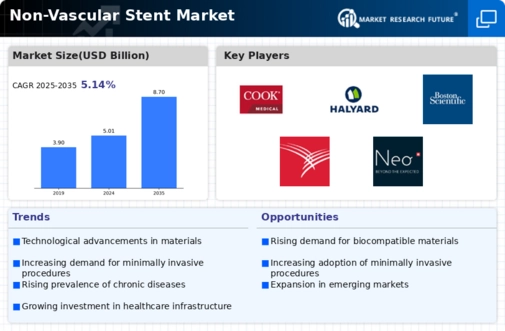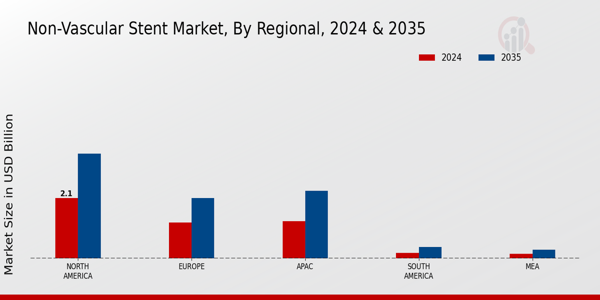Market Growth Projections
The Global Non-Vascular Stent Market is projected to experience substantial growth, with estimates indicating a market value of 5.01 USD Billion in 2024 and a potential increase to 8.7 USD Billion by 2035. This growth trajectory suggests a CAGR of 5.15% from 2025 to 2035, reflecting the increasing demand for non-vascular stenting solutions. Factors contributing to this growth include technological advancements, rising chronic disease prevalence, and an aging population. The market's expansion is indicative of the broader trends in healthcare, where innovative solutions are increasingly sought to address complex medical challenges.
Increasing Geriatric Population
The global demographic shift towards an aging population significantly influences the Global Non-Vascular Stent Market Industry. Older adults are more susceptible to various health issues, including those requiring stenting procedures. According to the United Nations, the number of people aged 65 and older is expected to double by 2050, reaching approximately 1.5 billion. This demographic trend suggests a sustained demand for non-vascular stents, as healthcare systems adapt to the needs of an aging population. Consequently, the market is anticipated to grow, with projections indicating a value of 8.7 USD Billion by 2035.
Rising Prevalence of Chronic Diseases
The increasing incidence of chronic diseases such as cancer and gastrointestinal disorders drives the Global Non-Vascular Stent Market Industry. As these conditions often necessitate stenting procedures for effective management, the demand for non-vascular stents is likely to rise. For instance, the World Health Organization reports that cancer cases are projected to increase by 70 percent over the next two decades. This trend suggests a growing need for innovative stenting solutions, contributing to the market's expansion. The Global Non-Vascular Stent Market is expected to reach 5.01 USD Billion in 2024, reflecting the urgent need for advanced medical interventions.
Regulatory Support and Reimbursement Policies
Supportive regulatory frameworks and favorable reimbursement policies play a crucial role in the Global Non-Vascular Stent Market Industry. Governments and health authorities are increasingly recognizing the importance of non-vascular stents in improving patient outcomes. For instance, streamlined approval processes for innovative stenting technologies can accelerate market entry. Additionally, favorable reimbursement policies enhance accessibility for patients, thereby driving demand. This regulatory environment is likely to foster growth in the market, as stakeholders navigate the complexities of healthcare delivery. The combination of supportive policies and innovative products positions the market for sustained expansion.
Technological Advancements in Stenting Solutions
Technological innovations in stent design and materials are pivotal in shaping the Global Non-Vascular Stent Market Industry. The introduction of biodegradable stents and drug-eluting stents enhances patient outcomes and reduces complications. For example, advancements in polymer technology have led to the development of stents that minimize the risk of restenosis. These innovations not only improve the efficacy of treatments but also expand the range of applications for non-vascular stents. As a result, the market is projected to grow at a CAGR of 5.15% from 2025 to 2035, indicating a robust future driven by continuous technological evolution.
Growing Awareness and Acceptance of Minimally Invasive Procedures
There is a notable increase in the awareness and acceptance of minimally invasive procedures among patients and healthcare providers, which is beneficial for the Global Non-Vascular Stent Market Industry. These procedures often result in shorter recovery times and reduced hospital stays, making them more appealing. As patients become more informed about their treatment options, the demand for non-vascular stents is likely to rise. This trend aligns with the broader shift towards patient-centered care, where the focus is on improving quality of life. The market's growth trajectory appears promising, driven by this evolving patient perspective.







